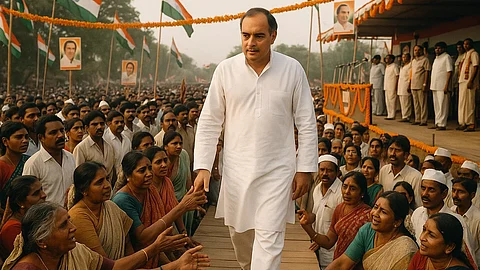
- Home
- न्यूजग्राम
- India
- World
- Politics
- Entertainment
- Culture
- Lifestyle
- Economy
- Sports
- Sp. Coverage
- Misc.
- NewsGram Exclusive
- Jobs / Internships

On May 21, 1991, Thenmozhi Rajaratnam, a Liberation Tigers of Tamil Eelam (LTTE) activist, assassinated former Prime Minister Rajiv Gandhi by detonating an RDX-laced belt while greeting him at Sriperumbudur in Tamil Nadu. LTTE was a militant organization that sought a separate Tamil Eelam state for Sri Lankan Tamils. The tragic death of the then Leader of the Opposition is still remembered for its impact, even after three decades.
Rajiv Gandhi was the former Prime Minister of India, elected at the age of 40, making him the youngest PM in the history of the country. He was a descendant of one of the most powerful political families, with a history spanning decades. The heir of the Nehru-Gandhi family was appointed as the Prime Minister of India on the same day as the assassination of his mother, Indira Gandhi, who was killed by her two Sikh bodyguards on 31st October 1984 in New Delhi.
Rajiv Gandhi's Political Background
Gandhi served in office from 31st October 1984 to 2nd December 1989, he got actively involved in politics after the death of his brother Sanjay Gandhi in a plane crash on June 23 1980. Rajiv Gandhi was always known for his ability to refrain from making hasty decisions. He led his party to a ground-breaking victory in the Lok Sabha elections of 1984. His administration was keen on reforming the existing government bureaucracy and moving towards opening the nation’s economy to private players through liberalization.
During his tenure as the Prime Minister, Mr. Gandhi had a desire to liberalise India’s trade policy however these reforms were opposed by the opposition at the time. His government came under radar for a corruption scandal involving weapon purchase known as the Bofors Scandal— a weapons contract between India and Sweden. The scandal involved numerous allegations of Indian officials, politicians, and bureaucrats receiving bribes in return for a military contract with the Indian army from AB Bofors- former Swedish arms manufacturer.
The news of scandals, corruption, and allegations erupted against the governing party, which later on led to Rajiv Gandhi’s defeat in the parliamentary elections resulting in his resignation in December 1989. V. P. Singh won the elections in 1989 and became the 7th Prime Minister of India; he held office from 1989 to 1990.
Rajiv Gandhi’s association with the Sri Lankan government during the Sri Lankan civil war only escalated the tension with the Tamil Tigers, a militant separatist organisation that operated in Sri Lanka also known as LTTE, after Gandhi vowed to deploy the the Indian Peace Keeping Force (IPKF) in Sri Lanka once he won the parliamentary election.
Ethnic tension rose even further when the Sinhalese-dominated Sri Lankan government passed the Ceylon Citizenship Act in 1948, which restricted the Sri Lankan Tamils from obtaining citizenship. As time passed, the LTTE group was growing in numbers and strength.
In response, the Sri Lankan government signed the Indo-Sri Lanka Accord in July 1987 with India in Colombo to demobilize the militant groups and resolve the conflict in the state by addressing the concerns of the Tamil minority. In the same year, Rajiv Gandhi deployed the Indian Peace Keeping Force (IPKF) to neutralise the LTTE and other militant groups, which faced immense resistance from them. Gandhi lost the elections in the subsequent term, and the IPKF was withdrawn from the state by Prime Minister V.P. Singh.
Rajiv Gandhi’s unshaken vow of resending the IPKF troops if he was re-elected in the next term made him a potential threat to the Tamil Tigers, which angered the militant group’s leader, Velupillai Prabhakaran.
The Day of Assassination
During the campaigning for the 10th Lok Sabha election Rajiv Gandhi was travelling across the country as part of his election campaigning. On May 21, 1991 Rajiv Gandhi left for Tamil Nadu’s Sriperumbudur to address the rally waiting for him, right after making a visit to Andhra Pradesh. While Gandhi was addressing the loud crowd, who were cheering his mother Indira Gandhi's name, he moved towards the crowd’s section. He first approached the men’s section, after which he moved towards the women’s section.
Among the crowd who were cheering and shouting, a young follower came near to greet him. Even though she was stopped by a woman police constable, Gandhi urged them to let his followers meet him. Thenmozhi Rajaratnam, also known as Dhanu, a 22-year old woman who was an LTTE operative allowed to meet the former Prime Minister, was hiding an “RDX-explosive-laden belt,” below her dress.
It was later revealed by the witnesses and investigators that Rajiv Gandhi's body was identified through his Gucci wristwatch and Lotto shoes.
The assassination shook the nation to its core. Rajiv Gandhi assasination accused-Perarivalan, Murugan, Santhan, and Nalini were given a death sentence in 1999 by the Supreme Court. Nalini’s sentence was reduced to a life sentence in 2000 whereas Perarivalan, Murugan, and Santhan’s sentences were commuted in 2014. [Rh/VS]
